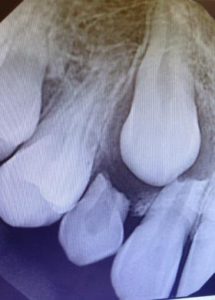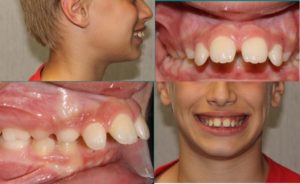
Photo Credit: Gerald W. Wesley
At what age should I bring my child in for an orthodontic evaluation? We perform hundreds of new patient exams each year in our office. I feel that this is one of the greatest parts of being a healthcare provider! The opportunity to meet such a broad, diverse range of people. Each interaction brings a new and unique experience. I don’t have to travel 15 hours, with a 10 hour layover, before getting on another 8 hour flight to Thailand (true story) to learn about new cultures and people. I get that right in our office every day! Not a single two people I have met have been the same. Just as diverse as these interactions are, so is the consensus on what the proper age for a child’s first orthodontic examination.
The American Association of Orthodontist recommends that a child receive their first orthodontic exam no later than the age of 7. That’s right! We recommend you have your initial orthodontic evaluation at the young age of 7. This comes as a shock to most. Why so young?! “They don’t even have enough teeth in yet,” or “I didn’t get braces until I was in middle school!” are the most common responses that we field. In most cases, I totally agree that they are too young to start at the age of 7 or even 8, 9, and 10. Ideally, I do prefer that all of the adult teeth are in the mouth before we begin with braces or Invisalign. While dental development does not necessarily correlate to your overall development, most of us will typically have all of our adult teeth by the age of 12. Although we would like to wait until all of the adult teeth are erupted, there are some dental issues that just cannot wait.
One of the coolest things about being an orthodontist is we literally get to watch our patients grow up! I duck down to introduce myself to most and by the time the braces come off I am on my tippy toes wishing those same children all the best. What I’m getting at is that the ages from 7-15 are very critical developmental years for us. These ages provide unique windows of opportunity to guide development in the right direction or correct issues that cannot be corrected at later ages.
What are we looking at?
First and foremost, teeth! Was that too obvious? Our first adult teeth start coming in at the age of 6. By the age of 7, the first molars and central incisors (front teeth) are erupted and all of the baby teeth in between should still be in the mouth. If these adult teeth are not in the mouth by the age of 7 we need to know why. It could be that they are missing or more likely that they do not have enough space to come in. If any of the baby teeth have fallen out earlier than they should have the adult teeth will start to come in at places and times that they are not supposed to. This could cause space loss or damage to neighboring teeth.

Figure 1 This x-ray shows adult canines that are erupting into the adjacent teeth. Luckily, there has not yet been any damage to the surrounding teeth. These upper canines are notorious for erupting where they are not supposed to and causing damage to the other teeth around them. This patient does not have any significant damage to any of his teeth and we have begun treatment to minimize the risk of any future damage.

Figure 2 This individual was not as lucky as the one in Figure 1. We can see that the erupting upper canine has caused significant damage to the adult tooth next to it. The root of the upper lateral incisor is almost completely gone. Without any root, this tooth will not last much longer (think about a post in the ground). This tooth is a front tooth and very important for esthetics. It is much easier to catch these situations early than it is to try to replace this tooth later.
The next thing we are looking at is the relationship of the jaws to each other and to the rest of the face. On occasion, one jaw is ahead of the other from front to back. Many people see this presented as an “overbite” or “underbite.” We may also see that one jaw is too narrow or too wide compared to the other. As mentioned earlier, there is a unique window of opportunity to address a lot of these issues. From the ages of 7-10 the bones are still very “moldable” and we can take advantage of this by doing some growth modification. After the age of 10, that window of opportunity begins to close and becomes completely closed when we are done growing around the ages of 15-17. By monitoring growth and acting when necessary, we are able to avoid what would be more complex treatment later in life. We could potentially avoid surgery in a lot of these cases!

Figure 3 We can appreciate here that the upper jaw is much narrower than this patient’s lower jaw. This narrow upper jaw does not allow enough space for all of the teeth to erupt and could cause asymmetric growth of the jaws and face.

Figure 4 This young lady has a lower jaw that is significantly set back compared to the upper jaw.

Figure 5 This example is quite the opposite of Figure 4. If you look closely, you can see that this young lady’s upper lip is set back compared to her lower lip. Figure 6 shows you exactly how her teeth present. If we were to look at her x-rays, she would look just like the x-ray shown in Figure 7. Notice how the upper jaw is behind the lower jaw. Most of the time this is easily corrected if we act before the age of 10!


Habits. While we can use some growth modification techniques at this young age, some habits can create problems just as easily. The most common ones we see are thumb sucking, poor tongue posture or a “thrusting” tongue. We have many techniques to help with these habits. Often times, correcting the habit early on will lead to correction of the teeth on their own.

Figure 8 This young man presented to us at the age of 16. He has had a persistent thumb-sucking habit since a young age. Now that he is older, we can see from Figure 8 and Figure 9 that the tongue fills that space and makes it even more difficult for him to swallow and speak. This also makes it a much more difficult problem for us to treat. It is critical that thumb-sucking, pacifiers or any other habits of this nature are eliminated well before the age of 6 or 7 (when the adult teeth start coming in).
Function! Although we all think orthodontics is about having that Hollywood smile, our teeth serve a very important purpose. We want to make sure your jaw joints are healthy and that you have normal range of motion. We also want to make sure that your teeth come together correctly. If they do not, they can often cause damage to opposing teeth or the gums that surround them. Are you grinding your teeth? You have adult teeth now and you do not get another set. Therefore, we check to make sure you are not wearing down your teeth at such a young age. We can offer simple solutions to provide protection when we do see this happening. The teeth also play a role in the function of your speech. Certain syllables, letters or sounds are dependent on proper tooth positioning.
References:

Figure 10 Although there are several issues we can point out here, I really want to show you how the front teeth are coming together. This is called an anterior crossbite. The front teeth are not made to bang against each other like this and therefore we say they are in a “traumatic” bite. As these front teeth hit against each other, the front tooth is pushed forward and over time we will get recession (the gums dipping down) and severe mobility. This also interferes with proper growth and development as it can “lock” the jaw into an unfavorable position.
Trauma prevention and aesthetics. A classic case is a young boy or girl with central incisors that are really sticking out (Figure 11). This can lead to some self-confidence issues. Although we often correct teeth of this nature to improve image and confidence our primary concern is decreasing the risk of trauma. The prevalence of incisor injury is 4-49% and is most often seen in males from ages 8-12 (Kinia et al)..

Figure 11 This particular young man had some issues at school with bullying, image and self-confidence. These are all good reasons to treat at this age. Another reason that we highly advise to correct proclined teeth early is that they are an increased risk for trauma. If you look at the top left picture of this young man, you can see that his lip gets trapped behind his teeth. This pressure from the lip will continue to push these teeth forward unless they are corrected.
Finally, we look beyond your teeth and jaws. We are by no means a replacement for your pediatrician or physician but rather another member of your health care team. Since we deal with a lot of growth and development, many “red flags” can be identified for early detection of several systemic issues. Our screening of the head, neck and face has helped us detect early arthritic conditions, hormone imbalances, bone formation conditions and most often airway complications. Obstructive sleep apnea in adolescents is often undiagnosed and presents itself with dental side effects. This is a huge discussion that I will cover in another post. To summarize, airway issues in children can lead to behavioral, growth and development, cognitive and cardiovascular issues. We work closely with ENT specialist to identify these airway complications early.
Ok, I rattled off a lot of complications here and some of you may be worried sick by now. Here’s the good news! I very rarely have to recommend treatment to a 7 year old. Usually, we can wait until the age of 8,9 or 10. In fact, most of the time we do not even have to start until all of the adult teeth are present. Another way to say this would be, most problems that we see now can just as easily be addressed later when we are ready for full orthodontic treatment with braces or Invisalign. We just recommend the proactive route to be safe. Still worried? Don’t be! Leave the worrying to us at Lifetime Orthodontics. Your initial exam comes at no cost and we will continue to monitor development and eruption with complimentary photographs every 6 months. We are here for you!
“A child can teach an adult three things: to be happy for no reason, to always be busy with something, and to know how to demand with all his might that which he desires.” -Paulo Coelho
- http://www.entnet.org/content/pediatric-sleep-disordered-breathingobstructive-sleep-apnea
- https://www.aaoinfo.org/system/files/media/documents/Right_Time_for_Ortho-MLMS-hl.pdf
- Kania, M. J., DDS, Keeling, S. D., DDS, McGorray, S. P., PhD, Wheeler, T. T., DMD, PhD, & King, G. J., DMD,DMSc. (1996). Risk factors associated with incisor injury in elementary school children. Angle Orthod, 66(6), 423.
